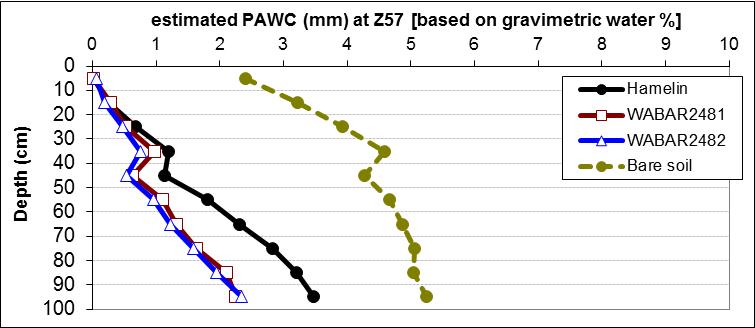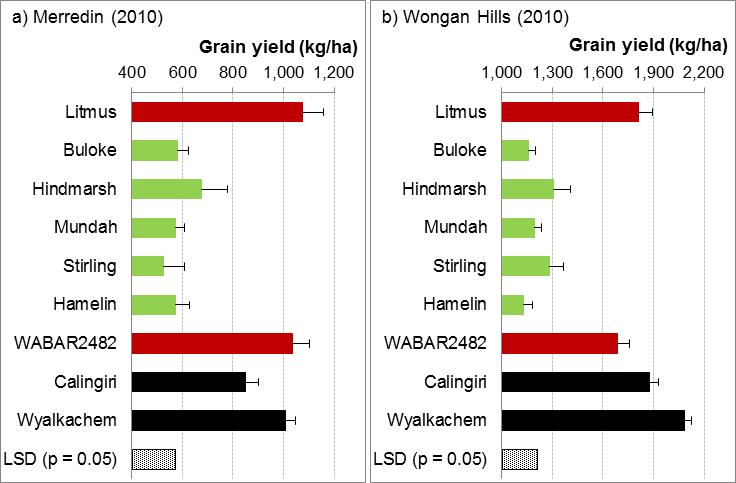Litmus barley improved tolerance to soil acidity
Litmus barley improved tolerance to soil acidity
Author: Blakely Paynter - Department of Agriculture and Food WA | Date: 06 May 2014
Litmus barley – improved tolerance to soil acidity
Blakely Paynter, Department of Agriculture and Food Western Australia
Key messages
- Litmus barley is competitive with standard wheat varieties like Calingiri and Wyalkatchem on acidic, sandy textured soils.
- Litmus barley is not an alternative to or a replacement for the application of lime.
- The release of Litmus barley increases the rotation options for growers with acidic soils.
Background and aims
The productivity of barley decreases as soil pH decreases. This is due to the sensitivity of barley to low soil pH and its sensitivity to the aluminium (Al) which becomes more soluble in solution as soil pH decreases. The target pH for a healthy soil is a surface pH (0-10 cm) ≥ 5.5 and a sub-surface pH (20-30 cm) ≥ 4.8 (Gazey and Davies 2009).
The solution to improving barley productivity on acidic soils is to apply lime. Improving the genetic tolerance of barley to low soil pH and Al toxicity does not replace the need for lime. It does however offer growers the opportunity to sow a cereal other than wheat in the rotation and/or improve the yield stability of barley where there is spatially variability in soil pH.
Pre-breeding research at the Department of Agriculture and Food has been looking internationally for germplasm with enhanced tolerance to low soil pH and high Al that can be used as parents in commercial breeding programs. Litmus, recently released by InterGrain and Syngenta, is based on a cross to the acid tolerant line WB229. On acidic soils WB229 has been shown to be 42% higher yielding than Stirling (Li 2008). Through marker assisted selection the Alt1 gene found in WB229 has been carried into the new barley cultivar Litmus.

Figure 1 Estimated plant available water (PAWC, mm) during flowering (Z57) for Hamelin, two Hamelin BC4s carrying the Alt1 gene and bare soil at Wongan Hills, 2010 (source: Paynter and Hills 2012).
On acidic, sandy textured soils breeding lines carrying the Alt1 gene have been shown to be 10 – 40% higher yielding than their parental line (Chengdao Li, pers comm; Paynter and Fettell 2011; Paynter and Hills 2012). The Alt1 gene increases 10-fold the excretion of citric acid from the root apices of barley plants. The exudated citrate reduces the toxicity of Al in the immediate area surrounding the root apex and allows the barley roots to increase their proliferation in the soil. This results in increased water extraction from the soil profile and a higher yield potential. This was demonstrated in a study by Paynter and Hills (2012) with the barley cultivar Hamelin and two Hamelin BC4s (WB229/4*Hamelin) carrying the Alt1 gene. Paynter and Hills (2012) showed that the Al tolerant Hamelin BC4s were higher yielding (average yield increase of 34% across six trials on acidic soils at Merredin and Wongan Hills) because they grew more tillers resulting in more grains per m2 and each grain was heavier than the grain produced by Hamelin. This was all as a consequence of being able to extract more water from the soil (measured to 1 m) (Figure 1).
With the commercial release of the acid tolerant barley cultivar Litmus, growers are asking how good is Litmus barley relative to wheat on high Al, low pH soils. The aim of this study was to compare the performance of Litmus barley against standard barley and wheat cultivars in two contrasting seasons (2010 and 2011) on recently limed and un-limed acidic, sandy textured soils at Merredin and Wongan Hills.
Method
In 2008, lime strips were setup at Merredin and Wongan Hills Research Stations (soil type, yellow sandy earths). Lime sand at 3.5 and 3t/ha respectively was spread in 20 m wide strips in a randomised, replicated split plot layout with 20 m wide nil lime strips. There were 3 replicates per treatment. Using those sites, cultivar trials were sown in 2010 and 2011 (on neighbouring areas) to evaluate the interaction between cultivar (27 barley and 3 wheat) and lime application on soils low in soil pH and high in Al. Soil pH and Al to 30 cm depth for the nil and plus lime strips at both locations and for both years was measured (Table 1). Plots were harvested with a small plot header and the plot weight recorded (Figure 1). Analysis of variance (ANOVA) was done in GenStat for Windows (2012) 15th edition.
Table 1 Location, May-Oct rainfall (season and long term decile 5), date sown, soil pH in 10 cm increments to 30 cm and soil Al in 10 cm increments to 30 cm for the nil and plus lime strips.
|
Location (year): |
Merredin (2010) |
Wongan Hills (2010) |
Merredin (2011) |
Wongan Hills (2011) |
||||
|
May-Oct rainfall: |
139 mm |
144 mm |
255 mm |
395 mm |
||||
|
Decile 5 rainfall: |
208 mm |
253 mm |
208 mm |
253 mm |
||||
|
Date sown: |
25-May-10 |
4-Jun-10 |
31-May-11 |
1-Jun-11 |
||||
|
Measurement: |
pH (CaCl2) |
pH (CaCl2) |
pH (CaCl2) |
pH (CaCl2) |
||||
|
Depth and lime: |
Nil |
Plus |
Nil |
Plus |
Nil |
Plus |
Nil |
Plus |
|
0-10 cm |
4.4 |
5.3 |
4.5 |
5.8 |
4.6 |
5.4 |
4.3 |
5.3 |
|
10-20 cm |
3.8 |
4.2 |
3.9 |
4.3 |
4.0 |
4.2 |
3.8 |
4.0 |
|
20-30 cm |
3.7 |
3.8 |
3.8 |
4.0 |
3.9 |
4.0 |
4.0 |
4.0 |
|
ANOVA |
LSD (p = 0.05) |
LSD (p = 0.05) |
LSD (p = 0.05) |
LSD (p = 0.05) |
||||
|
Depth |
0.2 |
0.1 |
0.1 |
0.2 |
||||
|
Lime x Depth |
0.3 |
0.3 |
0.1 |
0.4 |
||||
|
same Lime |
0.3 |
0.2 |
0.1 |
0.3 |
||||
|
Measurement: |
Al (µg/g) |
Al (µg/g) |
Al (µg/g) |
Al (µg/g) |
||||
|
Depth and lime: |
Nil |
Plus |
Nil |
Plus |
Nil |
Plus |
Nil |
Plus |
|
0-10 cm |
5 |
1 |
3 |
1 |
2 |
1 |
3 |
1 |
|
10-20 cm |
23 |
13 |
8 |
5 |
11 |
5 |
9 |
6 |
|
20-30 cm |
24 |
22 |
9 |
7 |
16 |
12 |
3 |
4 |
|
ANOVA |
LSD (p = 0.05) |
LSD (p = 0.05) |
LSD (p = 0.05) |
LSD (p = 0.05) |
||||
|
Depth |
2 |
2 |
2 |
2 |
||||
|
Lime x Depth |
5 |
n.s. |
n.s. |
n.s. |
||||
|
same Lime |
3 |
- |
- |
- |
||||
Results
Lime application increased the pH of the soil surface (0-10 cm) by around 1 unit and to a smaller degree (< 0.5 units) at 10-20 cm (except at Wongan Hills in 2011), with no impact at 20-30 cm depth (Table 1). There was no significant reduction in soil Al as a consequence of liming (except the 10-20 cm layer at Merredin in 2010).
Despite the impact of lime on soil pH to 20 cm, there was no improvement in grain yield (except at Merredin in 2010) due to liming (data not presented). There was no cultivar x lime interaction, but there were significant (p < 0.001) grain yield differences between cultivars.
Figure 2 compares the performance of Litmus and the Al tolerant barley line WABAR2482 (a Hamelin BC4) against 5 popular barley cultivars (Buloke, Hamelin, Hindmarsh, Mundah and Stirling) and two common wheat cultivars (Calingiri and Wyalkatchem) across the four sites.


Figure 2 Grain yield (± s.e.) of 7 barley cultivars (including 2 cultivars carrying the Alt1 gene, Litmus and WABAR2482) and 2 wheat cultivars (Calingiri and Wyalkatchem) averaged across the nil and plus lime strips at a) Merredin (2010), b) Wongan Hills (2010), c) Merredin (2011) and d) Wongan Hills (2011).
The Hamelin BC4 line WABAR2482 out-yielded its parental line Hamelin by 14% to 81% (Figure 2). This is in line with its performance in other studies (i.e. Paynter and Fettell 2011; Paynter and Hills 2012) and reinforces the value of the Alt1 gene in enhancing the performance on barley on acidic soils. Litmus had the same grain yield (p < 0.05) as WABAR2482 across the four sites.
Relative to the established barley cultivars Litmus was:
- higher yielding than Hamelin, Mundah and Stirling across all four sites,
- higher yielding than Buloke at all sites except at Wongan Hills in 2011, and
- higher yielding than Hindmarsh in the below average rainfall year of 2010 and the same yield as Hindmarsh in the above average rainfall year of 2011.
Relative to wheat, Litmus barley achieved the same grain yield (p < 0.05) as Calingiri and Wyalkatchem wheat in both the below average rainfall year of 2010 and the above average rainfall year of 2011
Conclusion
Litmus is an early maturing spring barley that is slightly shorter in plant height than Hamelin and Stirling, but with a similar risk of lodging. When growing Litmus a disease management plan needs to be implemented as it is moderately susceptible to powdery mildew and susceptible to all other leaf diseases. Litmus has been released as a feed barley and is available for planting in 2014. InterGrain has indicated they are likely to submit Litmus to Barley Australia to start Year 1 malting and brewing accreditation trials in 2015.
Litmus is the best commercially available barley cultivar for sowing on soils with an acidic profile. The reduction in its advantage in above average rainfall years is likely to be due to the increased availability of water in the top soil, nullifying the root pruning effect of low soil pH and high Al. The relative performance of Litmus on other soils has not yet been fully established. Analysis of NVT trials (2012-2013) and DAFWA-GRDC funded (DAW00190 and 224) barley agronomy trials will assist in understanding its relative variability across soil types and soil pH levels.
As Litmus is grain yield competitive with standard wheat cultivars like Calingiri and Wyalkatchem it provides growers in the northern and eastern wheat belt an opportunity to diversify their wheat-based rotation on soils with an acidic profile.
References
Gazey C, Davies S (2009). Soil acidity: A guide for WA farmers and consultants. Department of Agriculture and Food Western Australia, Bulletin 4784.
Li CD (2008). Using mutation technology to improve crops. Australian Grain 18(4): 36-37.
Paynter BH, Fettell NA (2011). Chapter 9: Cultural practices: Focus on major barley-producing regions. (Ed. SE Ullrich) Barley Production, Improvement, and Uses. (Blackwell Publishing Ltd.)
Paynter BH, Hills AL (2012). GRDC Final Report – DAW00190 “Barley agronomy for the Western Region 2009-2012”. Department of Agriculture and Food, Western Australia.
Key words
acid soil tolerance, aluminium tolerance
Acknowledgments
The author acknowledges the technical support of Sue Cartledge and DAFWA Research Support Units at Merredin and Wongan Hills.
GRDC Project No.: DAW00190
Paper reviewed by: David Meharry, InterGrain
